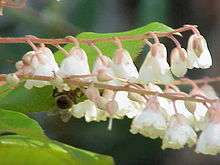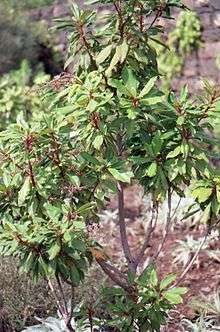Clethra arborea
Clethra arborea, commonly known as the lily-of-the-valley-tree,[2] is a flowering plant in the genus Clethra. It is found in Macaronesia where it is native to Madeira, extinct in the Canary Islands,[3] and considered an introduced species in the Azores. In Madeira its natural habitat is laurisilva forest.
| Clethra arborea | |
|---|---|
 | |
| Flowers | |
| Scientific classification | |
| Kingdom: | Plantae |
| Clade: | Tracheophytes |
| Clade: | Angiosperms |
| Clade: | Eudicots |
| Clade: | Asterids |
| Order: | Ericales |
| Family: | Clethraceae |
| Genus: | Clethra |
| Species: | C. arborea |
| Binomial name | |
| Clethra arborea | |
| Synonyms[1] | |
| |

Description
It is an evergreen narrowly upright shrub or small tree, growing to about 6 m tall and 4 m wide. The foliage is dense and glossy, with the leaves up to 7–10 cm long. The flowers are small, white and fragrant, similar in appearance to those of lily of the valley, hence the common name. (Lily of the valley is not closely related, being a monocotyledon.) The flowers are grouped in terminal panicles and bloom in early to mid summer.[4] The plant is toxic to humans; it contains andromedotoxin which may cause diarrhea and even sudden death.[5]
Cultivation
The tree prefers moist, acidic and well-drained soils, disliking alkaline soils. It is sensitive to frost and likely to die if the temperature falls below −3 °C. It is propagated by seeds, cuttings and air-layering.[4]
References
Notes
- "The Plant List: A Working List of All Plant Species". Retrieved 19 September 2015.
- "BSBI List 2007". Botanical Society of Britain and Ireland. Archived from the original (xls) on 2015-01-25. Retrieved 2014-10-17.
- Histoire naturelle des îles Canaries (Philipp Barker Webb & Sabin Berthelot), Ministre de l'Instruction Publique
- Cool Exotics.
- The Free Dictionary.
Sources
- "Clethra arborea". Cool Exotics. Archived from the original on 21 November 2010. Retrieved 16 May 2010.
- "Clethra arborea". The Free Dictionary. Retrieved 16 May 2010.
| Wikimedia Commons has media related to Clethra arborea. |